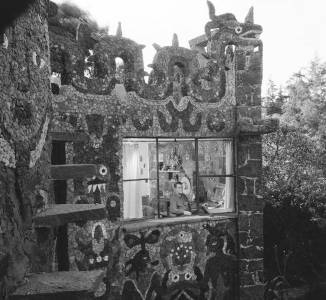dieser beitrag wurde verfasst in: englisch (eng/en)
künstler: Juan O'Gorman
titel: Mosaics
jahr: 1948
adresse: O'Gorman House, El Pedregal, Coyoacán, México D.F.
+: demolished in 1969
«[…] At the end of the 1920s and beginning of the 1930s, O'Gorman had championed functionalist architecture as part of a solution to fulfill the lack of shelter and hygienic structures for the majority of the population […]. In 1936, however, he became desillusioned with and ultimately rejected the functionalist architecture he had advocated because it had become a style that was used by developers and speculators to sell more buildings. O'Gorman's rejection was also based on that architecture's inability to communicate directly and clearly to the masses about their class interests and the fact that it reinforced the tendencies of capitalism to reproduce profits and class distinctions. His turn toward muralist and realist painting should be seen as part of his critique of the failure of modern forms to communicate. With the design of his own house (Mexico City, 1948) and the library for the UNAM (Mexico City, 1950–1951 […], O'Gorman began to work again on architecture. This return to architecture was centered primarily on his desire to create a 'realistic' architecture – similar in values to muralist painting – which, at the same time, was collective, was expressive of the social condition of the people, and emanated from the soil as a telluric expression. To communicate his social message and to highlight the importance of the consciousness of it by the viewer / user, O'Gorman added didactic messages via mosaic murals (as in the case of the exterior decoration of the library at the UNAM) or sculptural forms (throughout his house). His house at the edge of El Pedregal subdivision attests to his attempt to make architecture more visceral in its experience and irrational in its design (through the use of the natural qualities of the site and the construction of a 'grotto' or 'cave-like' interior space). The house was also to be 'organic.' In other words, it was based on O'Gorman's readings of Frank Lloyd Wright's ideas on organic architecture – an architecture shose forms and character were derived from the place where it was built. However, true to his funcionalist background, O'Gorman coupled those ideas with functionalist details […] as the had done with the studio for Frida Kahlo), the expression of the materials (in this case, the lava rock and mosaics), and the expression of the elements that made up the site (the rocky terrain and its vegetation). O'Gorman's paintings of the same period similarly reflect a rejection of rational or discursive thinking by depicting landscapes whose forms evoke other images and other paintings (such as, through reference, the work of Hieronymus Bosch) and could be said to be dreamlike in character and composition.» (from: Carranza / Lara, 2014, p. 97–98)
